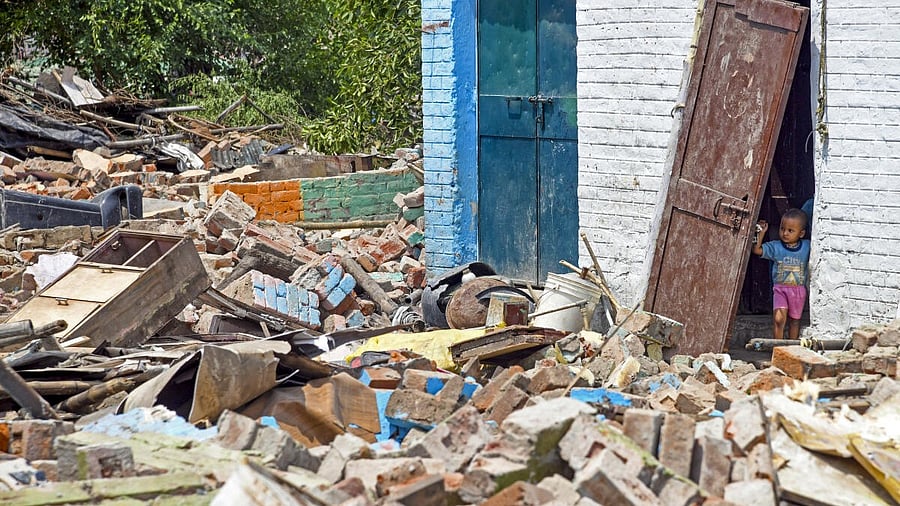
A child looks at the debris of an unauthorised structure after it was demolished at the slum cluster Janta Colony, in Chandigarh.
Credit: PTI Photo
Chandigarh: Residents of Chandigarh's Shahpur Colony look back on decades of memories and an uncertain future regarding alternate accommodation and disrupted livelihoods as bulldozers ran through their homes, bringing down the last remaining slum of the city.
The common capital between Punjab and Haryana became the country's first slum-free city after the demolition of Shahpur Colony, which was carried out on Tuesday, officials said.
The estate office pasted eviction notices in the area several days before the demolition drive was carried out, they claimed. All applications for rehabilitation were screened under the Chandigarh Small Flats Scheme, 2006, before the drive.
But some who did not have the required documents were left with no alternate accommodation.
"Where will I go with four daughters and a son now. The rent is too high in areas neighbouring our slum. Where will I go? I have not been given any alternate accommodation," said a middle-aged woman who has been living in the area for 20 years.
Authorities said the colony, spread over 4-4.5 acres of land valued at Rs 250 crore, comprised around 300 huts and tenements, housing nearly 1,000 residents.
Families eligible for rehabilitation were allotted EWS (economically weaker section) flats in Industrial Area Phase-I, Dhanas, Mauli Jagran, Ram Darbar and Sector 49, they said.
Sanjay, who was not found eligible for the rehabilitation scheme, faces a dire situation and is forced to look for a rented house.
He did not have all the documents which the authorities sought for giving a house to those affected by the demolition of the slum, he said, adding that he had been living in the slum for over two decades.
Another man who had been a Shahpur Colony resident for many years said he had been allotted a house in Industrial Area Phase 1, but said that "it was not livable".
Many living in Shahpur were migrants who earned their livelihood as labourers, and others sold vegetables and did odd jobs.
An elderly resident said, "Our livelihood has been disrupted and we have nowhere to go now. No politician has come to help us in this situation. At the time of elections, they made a beeline to seek votes, but no one is here now." "I have been living in Chandigarh for the past 40 years and can say that it is a good thing if there are no slums. But those affected by the demolition of slums should be suitably rehabilitated and their livelihood protected," said Baldev Kumar, an elderly resident here.
With the removal of all the unauthorised colonies from government land and the successful implementation of large-scale rehabilitation measures, the city has completed the final phase of its long-standing slum eradication initiative, officials said.
Over the years, the Chandigarh administration has successfully cleared 18 slum colonies, reclaiming nearly 520 acres of government land worth approximately Rs 21,000 crore, they said.
They added that the year 2025 marked decisive progress for the UT administration with major encroachment clearance drives.
In an official statement earlier, Chandigarh Deputy Commissioner Nishant Kumar Yadav said, "Through a combination of planned rehabilitation, strategic demolitions, and strict enforcement, Chandigarh has made a significant step forward in eliminating slums." "This initiative not only ensures the recovery of valuable public land but also provides thousands of residents with dignified housing and improved living conditions," he said.